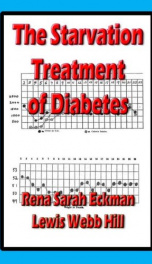The Starvation Treatment of Diabetes

From Preface: "For forty-eight hours after admission to the hospital the patient is kept on ordinary diet, to determine the severity of his diabetes. Then he is starved, and no food allowed save whiskey and black coffee. The whiskey is given in the coffee: 1 ounce of whiskey every two hours, from 7 a.m. until 7 p.m. This furnishes roughly about 800 calories. The whiskey is not an essential part of the treatment; it merely furnishes a few calories and keeps the patient more comfortable while he is being starved. If it is not desired to give whiskey, bouillon or any clear soup may be given instead. The water intake need not be restricted. Soda bicarbonate may be given, two drachms every three hours, if there is much evidence of acidosis, as indicated by strong acetone and diacetic acid reactions in the urine, or a strong acetone odor to the breath. In most cases, however, this is not at all necessary, and there is no danger of producing coma by the starvation. This is indeed the most important point that Dr. Allen has brought out in his treatment. At first it was thought best to keep patients in bed during the fast, but it is undoubtedly true that most patients do better and become sugar-free more quickly if they are up and around, taking a moderate amount of exercise for at least a part of the day. Starvation is continued until the urine shows no sugar. (The daily weight and daily urine examinations are, of course, recorded.) The disappearance of the sugar is rapid: if there has been 5 or 6 per cent., after the first starvation day it goes down to perhaps 2 per cent., and the next day the patient may be entirely sugar-free or perhaps have .2 or .3 per cent. of sugar. Occasionally it may take longer; the longest we have starved any patient is four days, but we know of obstinate cases that have been starved for as long as ten or eleven days without bad results. The patients tolerate starvation remarkably well; in no cases have we seen any ill effects from it. There may be a slight loss of weight, perhaps three or four pounds, but this is of no moment, and indeed, Allen says that a moderate loss of weight in most diabetics is to be desired. A moderately obese patient, weighing say 180 pounds, may continue to excrete a small amount of sugar for a considerable period if he holds this weight, even if he is taking very little carbohydrate; whereas, if his weight can be reduced to 170 or 160, he can be kept sugar-free, with ease, on the same diet. This is very important: reduce the weight of a fat diabetic, and keep it reduced. We have not found that the acetone and diacetic acid output behaves in any constant manner during starvation; in some cases we have seen the acetone bodies disappear, in others we have seen them appear when they were not present before. Their appearance is not necessarily a cause for alarm. The estimation of the ammonia in the urine is of some value in determining the amount of acidosis present, and this can readily be done by the simple chemical method given below. If the 24-hourly ammonia output reaches over 3 or 4 grams, it means that there is a good deal of acidosis-anything below this is not remarkable. More exact methods of determining the amount of acidosis are the determination of the ratio between the total urinary nitrogen and the ammonia, the quantitation of the acetone, diacetic acid and oxy-butyric acid excreted, and the carbon dioxide tension of the alveolar air. These are rather complicated for average clinical use, however."
Info about the book
Author:
Series:
Unknown
ISBN:
0312648707
Rating:
4.5/5 (3)Your rating:
0/5
Languge:
English
Users who have this book
Users who want this book
What readers are saying
What do you think? Write your own comment on this book!
write a commentGenre
if you like The Starvation Treatment of Diabetes try:
Other books by this author
Do you want to exchange books? It’s EASY!
Get registered and find other users who want to give their favourite books to good hands!

